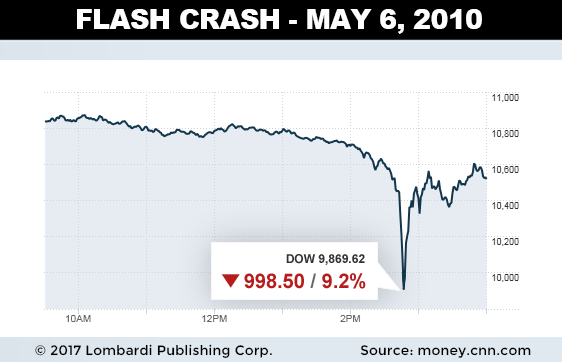The NASDAQ Crash Isn’t Permanent, But Market Fragility Is Concerning to Investors
No, this isn’t exactly a replay of the great NASDAQ crash of 2000. This latest crash is temporary, and share values will likely reset to their rightful levels by the time you read this. But this latest event raises questions about the relationship between equity values and the exchange algorithms that price them. If stocks can lose 87% of their value—albeit temporarily—without any explanation whatsoever, what happens when things get crazy? This is an important question to ponder, with trillions of dollars of retirement and 401K money at stake.
On the eve of July 4, 2017, Independence Day, something amazing happened—and not in a good way. Faulty market data, presumably emanating from the NASDAQ stock exchange, started showing crash-like values of several core financial platforms. Yahoo! Finance, Google Finance, Bloomberg terminals, and others showed equity values of some of the world’s biggest tech companies in free fall.
Also Read:
Stock Market Crash 2017? This Could Trigger a Stock Market Collapse
For example, the Amazon.com, Inc. (NASDAQ:AMZN) stock price fell from around $955.00/share to $123.47/share, which is about an 87% decline. Apple Inc. (NASDAQ:AAPL) was also quoted at $123.47/share, which meant it was down about 14%. Curiously, Microsoft Corporation (NASDAQ:MSFT) and shares of Zynga Inc (NASDAQ:ZNGA) rose dramatically, also to the $123.47/share level. It was a bizarre sequence of events all around. (Source: “Tech giants’ stock prices go haywire in apparent Nasdaq glitch,” The Australian Business Review, July 4, 2017.)
Furthermore, the abnormal price fluctuations triggered some stock halts in other securities, according to automatic messages sent out by the exchange. Known as “circuit breakers,” these messages are designed to halt or close market trading when certain percentage thresholds are exceeded. NASDAQ officials blamed improper test data by third-party vendors and vowed to resolve the problems expeditiously.
While there’s little reason to believe that something other than a simple error caused the problems, it still raises questions. In isolation, it could easily be dismissed, but this isn’t the first time something like this has happened. If something this drastic can happen in ubiquitous times, what happens when a real crisis comes along? How confident can investors be that a true event that causes a cascade of selling won’t torpedo the market completely?
Do you trust your life savings with electronic exchanges that can just crash because of “improper test data”?
Beware the Flash Crash
Some people might dismiss this recent NASDAQ crash as irrelevant. They reckon that the glitch is easily fixed, and take comfort that no actual trades were initiated this time around. That’s a fair point. But the underlying issue goes deeper. It’s a matter of robustness of the system, which—with trillions of dollars of market capitalization under its wing—is supposed to be unbreakable. It’s about trust of a network that’s completely digitized, when breakdowns occur frequently. What if the market completely melts down over unforeseen duress?
For investors who presided over the flash crash of 2010, the memory still burns bright. On May 6, 2010, a single investment bank attempted to sell $4.5 billion’s worth of S&P 500 futures, but ended up crashing the market. The Dow Jones Industrial Average (DJIA) dropped nearly 1,000 points in a few minutes on no significant news.
The Securities and Exchange Commission (SEC) concluded that a rogue algorithm failed to specify an amount or time frame for the selling, which led to dumping too many trades on the market. Other algorithms shut down once volatility spiked, causing liquidity to dry up. The buyers completely disappeared.
On May 18, 2012, technical glitches arising on the day of the Facebook Inc (NASDAQ:FB) initial public offering (IPO) lead to 30,000 stuck orders in the exchange system. Traders were left in limbo for more than two hours, not knowing whether their orders were filled or cancelled. The culprit was later determined to be a design flaw not found during testing.
On August 22, 2013, NASDAQ was embroiled by a “flash freeze,” in which securities fell offline for more than three hours. No NASDAQ-listed stocks could be traded during that time. The NASDAQ platform even seized up for non-listed shares. In effect, everything just went dark. The exchange later blamed a faulty security information processor (SIP) for the debacle.
Numerous other less pronounced flash crashes have occurred since then, jolting investor confidence. Not just on NASDAQ, but in the gold futures market, Ethereum (a cryptocurrency), and all major stock exchanges and currencies.
It’s bad enough when you can’t transact for whatever reason, but market liquidity is becoming a concern. Why? When volatility or other parameters are met, the algorithmic programs just shut off. Unlike the old days, they’re under no requirement to provide liquidity during a market event. Thus, buyers simply melt away, making the market prone to random implosions.
This latest NASDAQ crash wasn’t that, but it serves as a reminder on how fragile the market pricing really is. It’s another factor to consider when pondering the safety of your capital.







